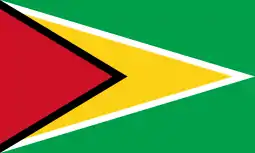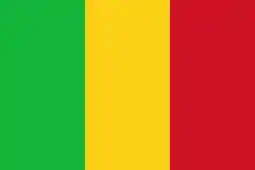Type 63 assault rifle
The Type 63 (Chinese: 63式7.62mm自动步枪), often incorrectly referred to as Type 68[1] by Western sources, is a Chinese-designed rifle with a resemblance to the SKS. However, the weapon features fully-automatic rotating-bolt system modified from the Type 56 assault rifle instead of the tilting bolt system of the SKS. Overall, the weapon is based on the Type 56 carbine (Chinese SKS) and the Type 56 assault rifle which are all seen by soldiers as part of the sks platform sks 63(sks Type 63.[2]
| Type 63 automatic rifle | |
|---|---|
 Type 63 rifle with folding bayonet. | |
| Type | Automatic rifle |
| Place of origin | China |
| Service history | |
| In service | 1963–1978 |
| Used by | See Users |
| Wars | |
| Production history | |
| Designed | 1959–1963 |
| Manufacturer | PRC government arsenals |
| Produced | 1963–1978[4] |
| No. built | ~6,000,000[4] |
| Specifications | |
| Mass | 3.8 kg (8.38 lb) |
| Length | 1,033 mm (40.7 in) |
| Barrel length | 531 mm (20.9 in) |
| Cartridge | 7.62×39mm |
| Action | Gas-operated, rotating bolt |
| Rate of fire | 750 rounds/min |
| Muzzle velocity | 735 m/s (2,411 ft/s) |
| Effective firing range | 500m |
| Feed system | 20-round detachable box magazine or standard 30-round AK-47 detachable box magazine (modification) |
| Sights | Hooded front post, rear U-notch on sliding tangent |
Development
The Type 63/68 was intended to replace the Type 56 semi-automatic carbine in Chinese service at one time when infantry felt the need for a compromise between rifle firepower and long rifle range and to help the Type 56 rifle integrate into service as there were too few of these to equip the entire PLA. The development of the Type 63/68 started in 1959; the design certificate was issued in 1963 (which is why the Chinese designation is "Type 63"), and the rifle entered service within the PLA in 1968 (which is why the weapon is referred to as the "Type 68" by Western experts).
Other than China, the biggest user of the Type 63 rifle was Albania, where it was exported in quantities when the Communist regime split from the Soviet sphere of influence to gain stricter relationships with China (to which it also granted, for a certain amount of time, a naval base in the Mediterranean Sea). The Type 63 rifle was also exported by China to North Vietnam during the Vietnam War, and throughout the 1970s,[5] it was also sent in smaller amounts to Burma, Cambodia and other countries in Asia and Africa. Shipments were also made to Afghanistan to support the local guerrilla fighters against the Soviet invasion.
North Korea also has used the Type 63 rifle in addition to their own locally produced SKS rifle's which are also called Type 63 (unsure if related to their use of Chinese Type 63 or just that they also by coincidence used the Type 63 for their locally produced SKS rifles)
Design
The Type 63 rifle is a select-fire weapon, fed by proprietary "cut-down" 20-round magazines or standard AK-47 30-round magazines, although these require minor modifications (removal of the bolt hold-open device) to fit. The fire selector is placed on the right side of the weapon right above the trigger guard, at index finger reach. The Type 63 rifle also features a non-removable folding spike-bayonet and a gas regulator system[1] to use standard live ammunition or blank ammunition for the launch of rifle grenades.[6][7]
The Type 63 was designed for semi-automatic fire with selective full-auto capability. The rifle was required by the People's Liberation Army to have higher accuracy compared to the Type 56 assault rifle. Moreover, the manufacturing process needs to be simplified to realize the military philosophy based on the use of masses in wartime. The weapon should facilitate the troops to be able to stop the enemy advance by rifle shots at extremely long distances as well as the use of the automatic fire for the final close-quarters engagements.[6][7]
The initial production of the rifle showed a promising result. Comparing to the Type 56 assault rifle, which is an AK-47 clone, Type 63 has higher reliability and better accuracy. It's fitted with the bolt hold-open device that AK-47 and Type 56 lacks. The service life of Type 63 is 15,000 rounds due to efficient structural design and streamlined manufacturing process, making it significantly better than the 6,000 rounds of Type 56 and AK-47 at the time.[6][7]
Production
Although the initial production of Type 63 received positive feedback from the troops, the final production of Type 63 encountered enormous disruption due to the Culture Revolution. The quality control of the production was severely affected, and the initial design was not respected. After the first batch of Type 63 finished production in 1969, subsequent batches received design changes that yielded questionable results. The service life degraded to 10,000 rounds instead of the promised 15,000 rounds. In retrospect, the weapon design was outdated as more compact, short-barreled assault rifles were taking the spotlight in modern warfare as shown in the US engagement in Vietnam.[6][7]
Rifle loading
The Type 63 can be loaded in four different ways because of its system:
- Using an empty 20-round magazine, cocking the action holds the bolt to the rear; a 10-round SKS-type charger can then be put into the feed guides and the rounds forced down. A second charger can be used to fully load the magazine.[8]
- 20 rounds can be forced down, one after the other, into the magazine.[8]
- A 20-round magazine can be pre-loaded off the gun and then placed in position.[8]
- If the bolt stop has been removed or ground down, a 30-round magazine can be used. But, it must be pre-filled off the gun as the bolt will automatically close on the empty chamber and close off the top feed opening.[8]
Users
 Afghanistan: Used by the Mujahideen.[9]
Afghanistan: Used by the Mujahideen.[9] Albania: Unknown users[9]
Albania: Unknown users[9] Cambodia: Unknown users[9]
Cambodia: Unknown users[9] China:[9] As of 2020, the Type 63 is mainly used in ceremonial events or with military honor guards.
China:[9] As of 2020, the Type 63 is mainly used in ceremonial events or with military honor guards. Guyana: Unknown users[9]
Guyana: Unknown users[9] Kosovo Liberation Army
Kosovo Liberation Army Mali: People's Movement for the Liberation of Azawad[10]
Mali: People's Movement for the Liberation of Azawad[10] North Korea:[11] The Korean People's Army (KPA) has used the Type 63 rifle in service due to support from the People's Republic of China, but now mainly uses it as a ceremonial weapon or in military parades. The Worker Peasant Red Guards however are known to use the Type 63 as they are a paramilitary organization who uses older weapons that were once used in the KPA. The DPRK also produces their own version of the SKS which also is called the Type 63 and has the North Korean star on the receiver however it bears more resemblance to the regular SKS in some areas of their produced Type 63 rifles.
North Korea:[11] The Korean People's Army (KPA) has used the Type 63 rifle in service due to support from the People's Republic of China, but now mainly uses it as a ceremonial weapon or in military parades. The Worker Peasant Red Guards however are known to use the Type 63 as they are a paramilitary organization who uses older weapons that were once used in the KPA. The DPRK also produces their own version of the SKS which also is called the Type 63 and has the North Korean star on the receiver however it bears more resemblance to the regular SKS in some areas of their produced Type 63 rifles. Vietnam: In Vietnamese service the rifle is designated K63.[12] It saw very little service in North Vietnam, and was withdrawn from front-line service after the Vietnam War ended. It is still in use by the DQTV.[12]
Vietnam: In Vietnamese service the rifle is designated K63.[12] It saw very little service in North Vietnam, and was withdrawn from front-line service after the Vietnam War ended. It is still in use by the DQTV.[12]
References
- Popenker, Maxim. "Type 63 rifle". Modern Firearms. Archived from the original on 2008-11-09. Retrieved 2018-10-18.
- "SKS Rifle". Gunner's Den. Retrieved 2008-11-01.
- "A member of the Kosovo Liberation Army (KLA) armed with a variant of the Zastava M70 [sic]".
- https://www.militaryfactory.com/smallarms/detail.asp?smallarms_id=610
- Tucker, Spencer C., ed. (May 2011). The Encyclopedia of the Vietnam War: A Political, Social, and Military History (2 ed.). p. 976. ISBN 978-1-85109-960-3.
- "Type 63 automatic rifle". Guns' world (in Chinese).
- "NORINCO Type 63 / Type 68 (SVS)". militaryfactory.
- "NORINCO 7.62 mm Type 68 rifle". Retrieved 2008-11-01.
- Bonn International Center for Conversion; Bundeswehr Verification Center. "Norinco Type 63". SALW Guide: Global distribution and visual identification. Retrieved 31 August 2018.
- Small Arms Survey (2005). "Sourcing the Tools of War: Small Arms Supplies to Conflict Zones" (PDF). Small Arms Survey 2005: Weapons at War. Oxford University Press. p. 166. ISBN 978-0-19-928085-8.
- https://old.weaponsystems.net/weaponsystem/AA04%20-%20SKS.html
- ""Sao vuông" Việt Bắc". ct.qdnd.vn (in Vietnamese). Retrieved 2018-04-14.
| Wikimedia Commons has media related to Type 63 rifle. |